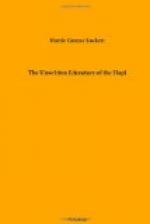“Oraibi Wash was already the line for the same purpose between Mishongnovi and Oraibi Village because of an older trouble.
“Well, when the enemies came from Mishongnovi to fight them, the Huckovi people had gathered many rocks and rolled them down from the mesa top, and killed so many that the Mishongnovi men started for home. But the Huckovi men came down then and followed them, and fought them every foot of the way back to Oraibi Wash, where they had to let them go free, and they went on running all the way home, and the Huckovi people then returned to their homes satisfied.”
* * * * *
The next two stories are by Dawavantsie, whose name means “sand dune.” She is a member of the Water Clan, and is the oldest woman now living in Walpi. She is much loved by the whole village, who claim that she is over a hundred years old. How old she really is, it would be impossible to know, for such things were not kept track of so long ago. She speaks no English. When asked about her age she merely shrugs her small shrunken shoulders, draws her shawl around them, and with a pleasant toothless smile, says: “O, I never know that, but I remember a long, long time.”
She loves to tell stories, and enjoys quite a reputation as a story-teller among her relatives and neighbors, who like to gather round and listen as she sits on the floor of her second story home, her back against the wall, bare feet curled up and quiet hands folded in her lap. Her face, while deeply wrinkled, is fine and expressive of much character as well as sweetness of disposition. Figure 14 shows her posing for her picture just outside her door, on the roof of the next lower room. Her skin and hair and dress are all clean and neat; her little back is astonishingly straight, and her bare brown feet, so long used to the ladders of Hopiland, are surer than mine, if slower.
She has lived all her life, as did her mother and grandmother before her, in this second story room, on whose clean clay floor we sat for the visiting and story-telling. From its open door she looks out over the roofs of Walpi and far across the valley in all directions, for hers is the highest house, and near the end of the mesa. The ancestral home with its additions is now housing four generations. She has always been a woman of prominence because of her intelligence and has the marks of good breeding—one of nature’s gentlewomen.
[Illustration: Figure 14.—Dawavantsie of Walpi.]
The writer’s friends, Dr. and Mrs. Fewkes, had told of her several years ago, for it was in her house that they had lived for some time in the early nineties while carrying on research work for the Bureau of American Ethnology. The writer did not realize that this was the house and the woman of whom she had heard till half-way through the first story, when some mention of Dr. Fewkes, by her son-in-law (a man past middle age) brought out the fact. When informed




